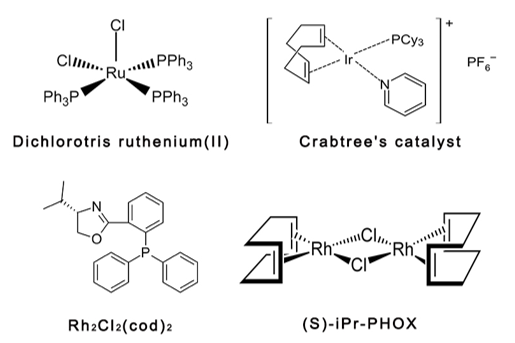The reaction between molecular hydrogen (H2) and another compound or element to reduce or saturate the organic compound under the action of a catalyst (nickel, palladium or platinum) or at a very high temperature is called a hydrogenation reaction. Hydrogenation reduces the double and triple bonds in the hydrocarbon.
Catalysts:
Hydrogenated catalysts generally fall into two broad categories: homogeneous catalysts and heterogeneous catalysts. The homogeneous catalyst can be dissolved in a solvent containing an unsaturated substrate. The non-homogeneous catalyst refers to a solid catalyst which is also suspended in the same solvent as the reaction or treated with a gaseous substrate. As depicted in figure 1 are several common homogeneous hydrogenation catalysts.
 Figure 1. The schematic diagram of several common homogeneous hydrogenation catalysts
Figure 1. The schematic diagram of several common homogeneous hydrogenation catalysts
More commonly found in the industry is a heterogeneous catalyst that is used for hydrogenation. Common hydrogenated heterogeneous catalysts are Raney nickel, Lindlar catalyst, Raney-Nickel catalyst, palladium-carbon, platinum, cobalt, and the like. In the industry, a precious metal hydrogenation catalyst is deposited as a fine powder from a solution on a support which is an inexpensive, bulky, porous, usually particulate material such as activated carbon, alumina, calcium carbonate or barium sulfate.
Applications:
The most common industrial hydrogenation catalyst is the heterogeneous catalyst mentioned above. Catalytic hydrogenation is mainly used in the food industry, petrochemical industry and organic chemistry. The following is a detailed introduction to the applications.
- Food industry: The largest scale application of hydrogenation is for the processing of vegetable oils. Typical vegetable oils are derived from polyunsaturated fatty acids (containing more than one carbon-carbon double bond). The degree of hydrogenation is controlled by limiting the amount of hydrogen, the reaction temperature and time, and the catalyst, which reduces most, but not all, of the carbon-carbon double bonds contained in the hydrogenation.
- Petrochemical industry: In petrochemical processes, hydrogenation is often used to convert olefins and aromatics to saturated alkanes (paraffins) and cycloalkanes, which has the advantage that the reaction is less toxic and less reactive and advantageous for storage. Because saturated hydrocarbons are more stable compared to alkynes and olefins, they exhibit superior storage properties. On the other hand, olefins tend to form hydroperoxides, which form gums, a substance that can be used to interfere with fuel processing equipment.
- Organic chemistry: In organic chemistry, hydrogenation is a useful measure to convert unsaturated compounds into saturated derivatives. The reaction substrate includes not only olefins and alkynes but also compounds containing an unsaturated bond such as an aldehyde, an imine and a nitrile. They are converted to the corresponding saturated compounds, namely alcohols and amines.
References
- Werkmeister, Svenja. (2014) 'Catalytic Hydrogenation of Carboxylic Acid Esters, Amides, and Nitriles with Homogeneous Catalysts'. Organic Process Research & Development. 18 (2): 289-302.
- Schrock, Richard R. (1976) 'Catalytic hydrogenation using cationic rhodium complexes. I. Evolution of the catalytic system and the hydrogenation of olefins'. Journal of the American Chemical Society. 98 (8): 2134-2143.
- Berkessel, Albrecht. (2002) 'Hydrogenation without a Transition-Metal Catalyst:On the Mechanism of the Base-Catalyzed Hydrogenation of Ketones'. Journal of the American Chemical Society. 124 (29): 8693-86938.
Leave a Reply
Related Products
You Might Like Also
Research Advancements in Carbon Nanotube Dispersion
Carbon nanotube dispersion has revolutionized various fields of science, including chemistry and materials science, due to their extraordinary mechanical, electrical, and thermal properties. Read More

Magnetic Metal Complexes
Magnetic metal complexes are a kind of magnetic compounds formed by combining paramagnetic ions and diamagnetic ligands by means of spontaneous assembly and controlled assembly. Read More
Phosphorus Catalysts
Phosphorus catalysts are widely used in organic chemistry laboratories to convert acetic acid and formaldehyde into acrylic acid or used to catalyze hydrodesulfurization (HDS) and hydrodenitrogenation (HDN). Read More
Application of Zinc Gluconate as a dietary supplement
Zinc gluconate is a white to almost white solid that is soluble in water, practically insoluble in anhydrous ethanol and methylene chloride. Read More
Organic Solar Cells
Organic photovoltaics have received extensive attention due to their excellent quality (the processability of the solution, adjustable electronic properties, low-temperature manufacturing and cheap and lightweight materials). Read More

Ligands for Functional Metal Complexes
Ligands for functional metal complexes usually have good coordination ability and chemical stability. Read More










